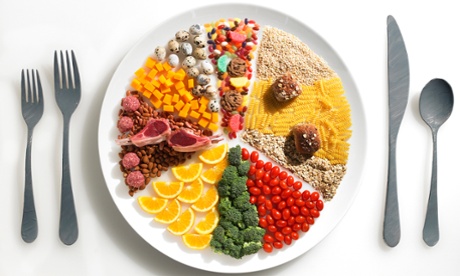The MasterChef judge is far from alone. Rather than balancing the flavours, lots of people eat their food in a specific order. Some can't even bear different foods to touch on the plate
Marcus Wareing is telling me the order in which he attacked his Sunday roast at the weekend. "I think people go first to what they love the most," says the chef and judge of MasterChef: the Professionals. "I just go straight for the potatoes, to be honest with you, because I'm the son of a fruit and potato merchant." So that's potatoes and sage-and-onion stuffing, followed by crackling, pork and finally the carrots and cauliflower.
When tackling meals, eaters tend to fall into two camps: a bit of everything on each forkful (me), or tackling each component separately (Wareing). Wareing says he sometimes tries to pace his devouring of each element on the plate equally, but adds: "I can't do it. I just think that's too much time wasted while the food is hot."
MasterChef fans might be surprised to hear that Wareing is a separate-components guy, because, on television, we always see the judges sampling a heavily loaded, mixed forkful. However, in unedited real life, they spend ages solemnly munching and assessing. "I usually go to the sauce first, or the main event, the protein, the fish, the meat, whatever," says Wareing, "and then taste all the individual elements." Only then will he mix it up: "It's about marriage, it's about balance, flavours coming together," he says cheffily.
Best first or last?
The separate-component camp splits into two distinct subgroups: those who gobble up the best bit first, and those who prefer to delay their gratification. Psychologists at the University of Pennsylvania are studying these very behaviours in American versus Indian people. The accepted wisdom is that Americans prefer a rising sequence in life - that is, for stuff to get better, as opposed to starting out good and staying the same, or starting out fantastic and becoming less brilliant.
"We were interested to see if such a preference translates to how Americans organise their daily activities," says Xuan Gao, who was charged with analysing the food-related data from the study. Subjects were asked if they eat in sequence, either "starting with my most favourite food, and ending with my least favorite food," or vice versa. Or whether they rotate through the foods, finishing them all around the same time (or follow some other sequence, or none at all).
Only 5% of the sample of 100 Americans ate the best bit first, while 35% saved the best till last. Like me, 36% perfectly paced their consumption of all elements on the plate. Likewise, rotating through the foods was the most preferred method among the Indian subjects (31%), with favourite food first, and favourite food last, neck and neck at 24%. In short, significantly more of the Americans preferred to save the best till last than the Indians, but rotating through the different foods wins across both the eastern and the western contingents.
Extreme food separation
Some adults find foods disgusting when they are mixed together. This can be quite acute, and even has an important-sounding name: brumotactillophobia. As one brumotactillophobic blogger writes: "I don't think the world is going to end if my chicken touches my broccoli but, honestly, I may not eat my meal if they do. It's not that I'd rather go hungry, but I physically can't put those foods in my mouth without my gag reflex involuntarily kicking into high gear."

This is often viewed as a hangover from childish picky eating. "Kids tend to only eat one item at a time," says the food psychologist Brian Wansink, and they often don't like these foods to be touching. (Hence the popularity of bento-style, compartmentalised lunch boxes and plates among bairns.) "That's got to have a real evolutionary basis to it," reasons Wansink. "If you have six foods together in a stew and you get really sick, all of a sudden you develop a natural distaste for all six of those foods because you don't know which one made you sick." Tip: Wansink's studies have revealed that arranging three meal components into six piles of non-touching foods on a plate is the most appetising to picky children.
Hunger's impact
Wansink has also compared which foods people eat first (at a buffet) after being deprived of food for 18 hours, with the choices of people who haven't fasted. As you would expect, the extremely hungry participants selected more carbohydrates and ate them first - things such as mashed potatoes, bread and macaroni cheese. These people ate fewer vegetables. By contrast, the non-deprived group - most regular diners - start with a few vegetables, then move on to the protein, and the carbs come last.
The final forkful
The last forkful is of utmost importance to me. As my cutlery scurries about my plate, picking up a bit of this, and bit of that, it almost automatically squirrels away a choice cut of everything for the end. Even Wareing, a dyed-in the-wool, best-first eater, keeps a weather eye on his final bon bouche. "That'll be the pork, with some potato and some stuffing - the three things I enjoyed the most. I'll have eaten all the crackling already," he enthuses.
Do you have a particular plate-clearing strategy? Can you read a person by their polishing-off preferences? Let us know below.
Marcus Wareing turns out to be a separate-components guy. Photograph: Graeme Robertson for the Guardian






